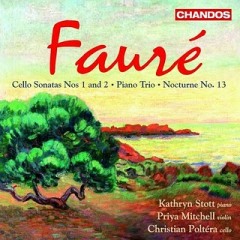Gabriel Faure – Cello Sonatas, Piano Trio, Nocturn (2008)
Gabriel Faure – Cello Sonatas, Piano Trio, Nocturn (2008)

1. Cello Sonata No. 1, Op. 109, I. Allegro
2. Cello Sonata No. 1, Op. 109, II. Andante
3. Cello Sonata No. 1, Op. 109, III. Finale. Allegro Commodo
4. Cello Sonata No. 2, Op. 117, I. Allegro
5. Cello Sonata No. 2, Op. 117, II. Andante
6. Cello Sonata No. 2, Op. 117, III. Allegro Vivo
7. Nocturne N° 13 En Si Mineur, Op. 119
8. Piano Trio, Op. 120, I. Allegro Ma Non Troppo
9. Piano Trio, Op. 120, II. Andantino
10. Piano Trio, Op. 120, III. Allegro Vivo
Kathryn Stott: piano
Christian Poltéra: cello
Priya Mitchell: violin
The two sonatas for cello and piano along with the D minor Piano Trio were among the last works that Fauré was to complete before his death in 1924 at the ripe old age of 79. Despite the many dire circumstances that filled the latter years of Fauré's life, and in light of his choice to score each of these pieces in dark, minor keys, all three compositions have many moments of complete joy. The two cello sonatas are performed by cellist Christian Poltéra and pianist Kathryn Stott. Both artists have an impeccable sense of line and flow and are able to spin out the long, wandering phrases Fauré lays down. The ensemble between cello and piano is as if a single instrument were playing, and Poltéra's intonation is gratifyingly precise. The cello's tone, however, is a bit on the thin side, and it seems as if the piano has to hold back in forte passages to avoid trouncing it. Violinist Priya Mitchell joins the duo for the performance of the D minor Piano Trio. Mitchell is able to match nearly all of the qualities of the other two musicians. The introduction of the violin, however, also sees the beginning of intonation difficulties between the two string instruments. Fauré extensively uses unisons and octaves throughout the piece, and even the slightest variation in pitch is at once noticeable. In this recording, it is noticed far too often. ---Mike D. Brownell, Rovi
download: uploaded anonfiles yandex 4shared solidfiles mediafire mega filecloudio
Zmieniony (Wtorek, 12 Listopad 2013 17:46)








